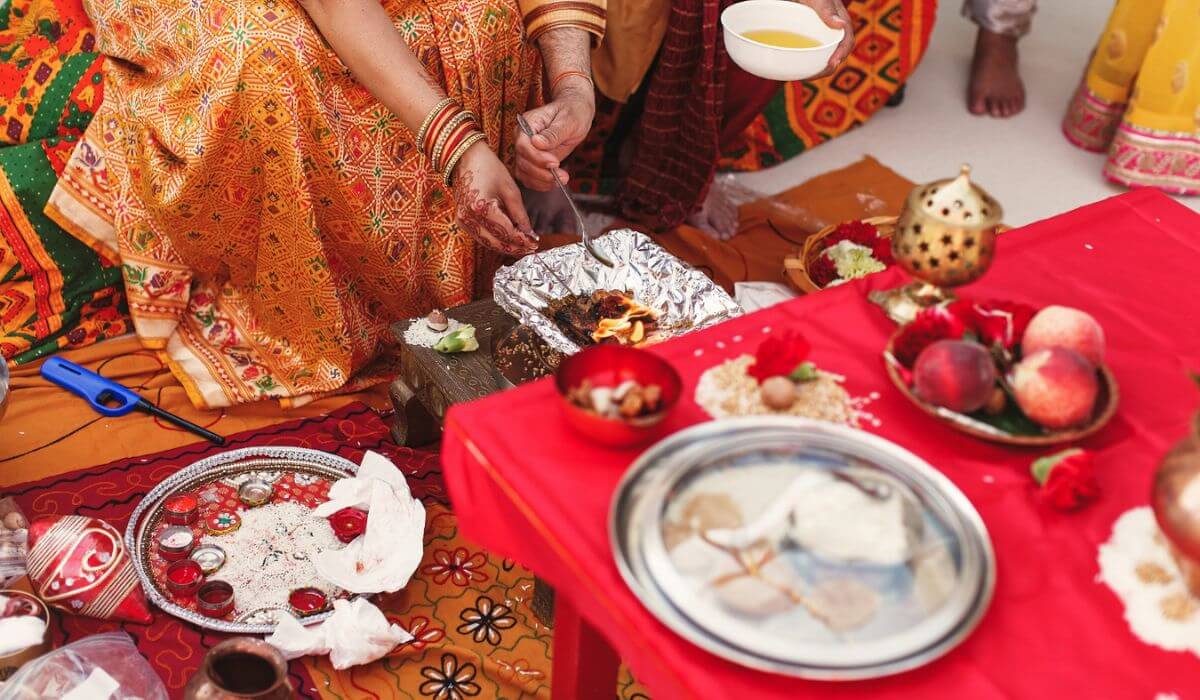Table of Contents
Shattila Ekadashi is a holy day in Hinduism that occurs on the Krishna Paksha of the Magha month. This period is the waxing phase of the moon. It’s also called Til Ekadashi, Stilla Ekadashi, Sattila Ekadashi and Tilda Ekadashi. The word shattila means “six sesame seeds” and this day is dedicated to the worship of Lord Vishnu and Lord Krishna.
On this day devotees fast and perform puja rituals to get blessings from the gods. They also donate sesame seeds to charity. It’s believed that sesame seeds are very sacred and are used during various religious ceremonies.
Shattila Ekadashi 2024: Date and Time
As per the Hindu calendar in 2024 Shatilla Ekadashi will be celebrated on February, 6th. The Ekadashi time begins at 5:24 PM on February 5th and ends on 4:07 PM on February 6th.
The Rituals of Shattila Ekadashi

Day before Ekadashi
- Cleaning and bathing: People usually clean their homes and take a bath.
- Collecting things for puja: Gather things required for the puja. You can set up an altar that has a statue or photo of Lord Vishnu and/or Lord Krishna. Keep offerings in the form of flowers, fruits, sweets, incense, lamps, a kalash (pot) with water and sesame seeds.
Ekadashi morning
- Rise early: Wake up before the sun rises possibly during Brahma Muhurat. It’s believed that this is an auspicious time to work toward spiritual goals.
- Meditation and bathing: Take a bath again and then meditate to clear your thoughts and remove any negative energy to set your goals.
Preparing for Puja
- Mantras and offerings: Chant mantras associated with Lord Vishnu and/or Lord Krishna. Offer the items you’ve prepared to the gods.
- Use sesame seeds in your offerings: You can offer sesame seeds in different forms. You can mix sesame seeds in water and sprinkle it on the idols or photos, you can prepare sweets using sesame seeds and offer them or make a paste using sesame seeds and apply it as a form of bath (uptan).
- Fasting ritual: There are various forms of fasting that are observed as per tradition and regions. However here are a few food items that are usually avoided such as grains, beans, salt and spices throughout the day. Alternatively some forms of fasting allow you to eat vegetables and milk products.
- Reading scriptures: Read scriptures like the Vishnu Sahasranama or the Shattila Ekadashi vrat katha.
Evening rituals
- Aarti and prayers: Once the sun goes down perform aarti (ritual involving lighted lamps) and recite prayers.
- Breaking the fast: Once the ritual of aarti is over you can break the fast and eat a light vegetarian meal that includes healthy food items.
What is the Shattila Ekadashi Vrat Katha?
There are various different Vrat Kathas of Shattila Ekadashi as per tradition and region. One of them is the story of Savitri an old woman who lived in a prosperous village. She was a wealthy and religious woman known for charity. But her idea of donation was limited to materialistic things such as clothes.
During one Ekadashi Savitri was getting ready to do her usual act of charity when an old and weak beggar showed up at her house. He begged for food but Savitri as usual gave him clothes as she thought food wasn’t a necessary donation. The beggar was upset and politely refused the donation and moved on.
Later that night Lord Vishnu came in Savitri’s dream as the same beggar. He told her who he was and expressed his disappointment in her. He educated her on the importance of feeding the poor especially on days like Ekadashi.
When Savitri woke up she understood her mistake and tried to find the beggar but couldn’t. She wanted to correct her mistake and prepared a meal and went out looking for the beggar.
She came across a young boy who pointed her to an old temple where he had seen an old beggar sleeping. When Savitri got there the beggar was already gone. Feeling disappointed she left the food at the temple door.
As she turned around to leave she heard a soft thud. She turned around and saw that the clay pot had broken and the food was lying on the ground. A voice from the inside of the temple said to her, “your offering has been accepted”.
Savitri finally understood the meaning of kindness especially on holy days like Ekadashi.
Shattila Ekadashi Significance
The significance of Shattila Ekadashi depends on the views and goals of each person. Some people focus more on the spiritual side while some may focus more on worldly benefits. It’s important to note that it can help with spiritual growth and bring good luck. Here are a few things that make this day important.
- Devoting to Vishnu and Krishna: It’s a time dedicated to Vishnu and Krishna and seek their blessings with praying, chanting and performing pujas.
- Importance of sesame seeds: The word Shattila itself means ‘six sesame seeds’ highlighting its importance traditionally. Offering sesame seeds is a sign of loyalty and dedication to the gods.
- Cleansing and renewing: It is believed that fasting during this time and performing the right rituals can wash away sins, purify the soul and spiritual growth.
- Fulfillment of wishes: People believe that performing the rituals and praying to the gods can help them receive their blessings and their wishes may get granted.
- Connection to scriptures: The Vrat Katha associated with this day teaches us important lessons about loyalty, kindness and the outcome of selfishness.
What are the benefits of this Ekadashi?
Spiritual Benefits
- Purification: As per religious beliefs it’s believed that fasting and performing the rituals during this time can get rid of negative karma and past sins.
- Spiritual growth: Praying, reciting mantras and meditating can help spiritual growth and develop the devotees connection with Lord Vishnu.
- Freedom: Some sacred scriptures suggest that following the rituals sincerely can give freedom to the devotee from the cycle of birth and death.
Material Benefits
- Prosperity: The offering of sesame seeds is believed to attract blessings and abundance leading to a better situation financially.
- Good health: Sesame seeds are often linked with healthy nutritional value and may also contribute to an improvement in health and well-being.
- Peace: It is believed that the rituals can attract peace and harmony among families.
Frequently Asked Questions (FAQs)
Q1: Why is Shattila Ekadashi celebrated?
The word Shattila means “six sesame seeds” and this day is dedicated to the worship of Lord Vishnu and Lord Krishna. Celebrating this day and performing the rituals is believed to help spiritual growth and bring good luck.
Q2: What is the meaning of Shattila?
The word Shattila means “six sesame seeds”. They are a part of the Vrat Katha and are often linked with healthy nutritional value and may also contribute to an improvement in health and well-being.
Q3: What is the significance of Sat Tila Ekadashi?
Here are a few things that make this day important.
- Devoting to Vishnu and Krishna: It’s a time dedicated to Vishnu and Krishna and seek their blessings with praying, chanting and performing pujas.
- Importance of sesame seeds: The word Shattila itself means ‘six sesame seeds’ highlighting its importance traditionally. Offering sesame seeds is a sign of loyalty and dedication to the gods.
- Cleansing and renewing: It is believed that fasting during this time and performing the right rituals can wash away sins, purify the soul and spiritual growth.
- Fulfillment of wishes: People believe that performing the rituals and praying to the gods can help them receive their blessings and their wishes may get granted.
- Connection to scriptures: The Vrat Katha associated with this day teaches us important lessons about loyalty, kindness and the outcome of selfishness.




